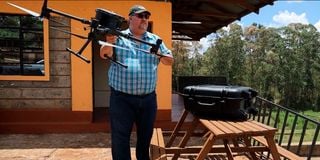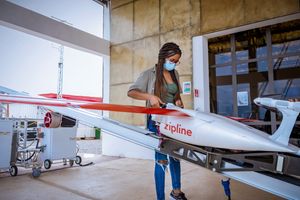Drone farming: Lessons from Idaho, US

Robert Blair, an American large-scale farmer of wheat, barley and beans, during the interview in Runda, Nairobi. Blair was in the country recently to educate farmers on drone farming.
What you need to know:
- While drones have been in wide application in farming for years in the western world, the gadgets are only becoming popular in Africa now.
- As adoption of drones continues to gain mass popularity in Kenya, the gadgets are also promising to revolutionise how most field activities are carried out. For nearly a decade now, drones have been used in journalism, conservation and defence surveillance.
His visit to Kenya last week may have been quiet, but Robert Blair’s presence was in may ways the beginning of a new phase in crop farming in the country. Blair is a farmer par excellence, with wheat, barley, beans and lentils among the crops he grows on large-scale in the US state of Idaho.
He is also an entrepreneur and advisor for AIGEN Solutions, an agricultural technology company. He was the first farmer in the US to own and use a drone in farming when he started in 2006. Today, he is recognised globally for his advocacy for precision farming.
The senatorial candidate of Idaho had come to Kenya to educate farmers on drone farming.
His entry into the drone space, though, was by happenstance. Blair had stumbled upon a newspaper advert on Unmanned Aerial Vehicles that piqued his interest. He says the drones available in the market at the time were using “off-shelf cameras, which took poor images that gave barely accurate” data .
Seventeen years later, these gadgets come with powerful scan software that produce high quality imagery for accurate mapping and surveillance. “The drone is not the most important thing. Being able to analyse the data captured is critical,” Blair explains on the use of drones in farming.
As adoption of drones continues to gain mass popularity in Kenya, the gadgets are also promising to revolutionise how most field activities are carried out. For nearly a decade now, drones have been used in journalism, conservation and defence surveillance.
Earlier this year, the director-general of the United Nation’s Food and Agriculture Organisation Qu Dongyu visited Kenya to launch operations of two large drones that will be used to monitor forest ecosystems and mapping in agriculture.
Now drones are also entering the agriculture space in Kenya as farmers turn to smart ways to monitor their crops for pests and diseases and for timely application of chemicals with a view to boost yields.
Besides increased yields, drones allow for more efficient use of water and labour, thus reducing farming costs. Additionally, they help to lower greenhouse gas emissions owing to their less fuel requirement compared to heavier, motorised farm equipment such as tractors.
“Drones capture high resolution and timely farm imagery, providing data that is important in making decisions in farm management decisions,” Blair says.
While drones have been in wide application in farming for years in the western world, the gadgets are only becoming popular in Africa now. Blair notes that drone farming will play an important role in food agriculture on the continent, where purchase of modern farming equipment is an expensive undertaking, which renders them inaccessible to many.
“I believe utilising drones to apply herbicides and different pesticides against pests and disease would take Kenyan agriculture to a new level,” he says.
He notes that spotting pests and diseases on a farm is sometimes challenging owing to the large acreage, adding that drones are able to spot any changes in the crops for immediate and relevant interventions. But it is their flexibility that makes them even more attractive.
“They are ideal to fly in areas with difficult terrain where traditional farm machinery may not access,” the farmer says.
Drone operations in Kenya are guided under the Civil Aviation (Unmanned Aircraft Systems) Regulations of 2020. Kenya Civil Aviation Authority (KCAA) is the government enforcement agency that also licenses users.
On how the US navigated earlier confusion to integrate drones in farming, Blair admits that the journey was fraught with setbacks. The Federal Aviation Administration (FAA), he recalls, struggled to establish specific guidelines on the use of the gadgets in agriculture.
“FAA did not want to hear anything from farmers. They were hesitant to allow use because (as farmers) we were not pilots or part of the aviation industry,” he recounts.
In 2013, the FAA started to gradually open up the US airspace for drone use by individuals. But to be allowed to fly them, farmers, like other drone users, had to obtain a certificate of authorisation (CoA) and an airworthiness certificate.
“The pilot had to have a manned pilot licence. There was no drone pilot licences at the time.”
He describes it as a cumbersome and bureaucratic process that was complicated by lack of laws. He says Kenya moved with speed to introduce laws, and notes that with proper stakeholder engagement, the country will overcome most of its teething problems within a shorter time.
“There is hope that the industry will work with KCAA to protect the airspace while ensuring easy use of drones by farmers,” adds Blair.
In the US, emphasis is put on large-scale food farming, with family farms playing a dominant role in the equation. The farms, many of them in Midwestern US, accounted for 99 per cent of US farms and 89 per cent of production in 2015, a report by the US Department of Agriculture (USDA) shows.
That year, family and non-family farms with more than $1 million (Sh132 million) in gross cash farming income accounted for half of the value of the US farm production, a substantial increase from about a third in 1991.
Expand production
In the 1970s, then US Agriculture Secretary Earl Butz publicised the ideology of large-scale farming. Butz is known for his slogan “get big or get out” implying that farmers who were unable to expand their production would effectively be pushed out of agriculture.
To Butz, going large-scale was more efficient in growing food crops such as corn and soya. The move saw hundreds of farmers buy additional acreage and upgrade to new machinery to increase production.
Meanwhile in Kenya, smallholder food crop farmers account for 60 per cent of the country’s agriculture. With the increasing frequency of erratic rains made worse by poor farming methods and inability to access modern farming equipment and quality seeds, the average Kenyan farmer is unable to feed his own household, much less the country.

While drones have been in wide application in farming for years in the western world, the gadgets are only becoming popular in Africa now
Is going large-scale the solution to food security? To Blair, it does not matter whether one is farming on 10 acres or 10,000 acres. Any piece of land can be farmed for maximum yield, he argues, saying that what must evolve in Kenya are the farming practices on small farms to boost yields.
“By just changing the practices, doing proper tillage, application of fertilisers and use of drones, the sky would be the limit. In my tour of the various parts of the country, I have been amazed by Kenya’s potential to produce enough food for its population and for export,” he says.
These are not the only low-hanging Kenyan farmers could pick, he says. “There are deep furrows in most farms. Farmers lose water because there is little penetration of the water in soil in the fields. Most of the water ends up evaporating,” he adds, emphasising the need to conserve water on farms.
“Idaho is in a section of the US that is semi-arid. But we are some of the largest producers of desert crops such as lentils and garbanzo beans in the world,” he notes, adding that he produces about 150 bushels (3.8 metric tonnes) of wheat per acre.
The quality of Kenyan soil, he observes, could support most crop varieties and thus help to secure the country with food. “The organic matter in Meru County, for instance, is between eight and nine per cent. In my State, the matter is between four and five per cent. The soils here are more virgin in a lot of aspects when it comes to farming. The production capacity should be higher.”
To him, it will take concerted efforts by the government, farmers, public entities, the private sector and other stakeholders in the ecosystem to make a difference.
“It is important to demonstrate to them the difference between conventional methods of farming and modern ways. The message has to be consistent. The methods also have to be affordable.”
Blair says crop insurance support by the USDA protects farmers from the risk of failed seasons, allowing them to continue farming even after incurring losses. In Kenya, the government does not provide this kind of support, with farmers having to deal with losses on their own.
“Kenyan farmers can work with different county and national government agencies to help them acquire different machinery and to adopt progressive farming techniques. Provisions of machinery for drilling water is one of the ways this could be done.”
Most importantly, he says, determining the challenges of farmers and prescribing the appropriate support will go a long way in unlocking Kenya’s food security. “There is nothing to stop this country from taking off in farming,” says Blair.





